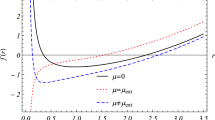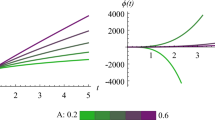Abstract
A spatially closed universe undergoing at present accelerated expansion, having a non-vanishing cosmological constant, and filled with luminous- and dark matter is described in terms of the Integrable Weyl–Dirac theory. It is shown that, during the dust-dominated period, dark matter and the quintessence pressure, the latter giving rise to acceleration: both are created by the Dirac gauge function. The behavior of two models: a nearly flat one and a well closed are considered in appropriate gauges, and plausible scenarios are obtained. The outcome of the present paper, together with results of a previous work,(31) provide a geometrically based, classical, singularity-free model of the universe, that has originated from a pure geometric Weyl–Dirac entity, passed a prematter period, the radiation-dominated era, and continues its development in the present dust period.
Similar content being viewed by others
REFERENCES
K. C. Freeman, Astrophys. J. 160, 811 (1970).
D. H. Rogstad and G. S. Shostak, Astrophys. J. 176, 315 (1972).
J. P. Ostriker, P. J. E. Peebles, and A. Yahil, Astrophys. J. Lett. 193, L1 (1974).
V. Trimble, Ann. Rev. Astron. Astrophys. 25, 425 (1987).
J. Kormendy and G. R. Knapp, eds., Dark Matter in the Universe (Reidel, Dordrecht, The Netherlands, 1987).
M. Turner, Phys. Scripta, T 36, 167, (1991).
S. Tremaine, Phys. Today 45, No. 2, 28 (1992).
A. Tyson, Phys. Today 45, No. 6 (1992).
W. Priester, J. Hoell, and H.-J. Blome, Comments Astrophys. 17, 327 (1995).
M. Israelit and N. Rosen, Found. Phys. 25, 763 (1995).
M. Israelit, in Proceedings of the Third Alexander Friedmann Int. Seminar on Gravitation and Cosmology, Gnedin et al. (eds.) (Friedmann Laboratory Publishing, St. Petersburg, 1995), pp. 126–143.
M. Israelit, Found. Phys. 29, 1303 (1999).
M. Israelit, The Weyl–Dirac Theory and Our Universe (Nova Science, Commack, New York, 1999).
S. J. Perlmutter et al., Nature (London) 391 51, (1998).
S. J. Perlmutter et al., Astrophys. J. 517, 565 (1999).
A. G. Riess et al., Astron. J. 116, 1009 (1998).
P. M. Garnavich et al, Astrophys. J. 509, 74 (1998).
R. R. Caldwell, Rahul Dave, and Paul J. Steinhardt, Phys. Rev. Lett. 80, 1582 (1998).
S. Weinberg, Gravitation and Cosmology (Wiley, New York, 1972).
E. Gunzig et al., Phys. Rev. D 63, 067301 (2001).
G. Esposito-Farese and D. Polarski, Phys. Rev. D 63, 063504 (2001).
T. Matos and L. A. Ureña-López, Phys. Rev. D 63, 063506 (2001).
M. S. Turner and M. White, Phys. Rev. D 56, R 4439 (1997).
V. Sahni and L. Wang, Phys. Rev. D 62, 103517 (2000).
P. Binétruy, Phys. Rev. D 60, 063502 (1999); Int. J. Theor. Phys. 39, 1859 (2000).
L. P. Chimento, A. S. Jacubi, and D. Pavón, Phys. Rev. D. 62, 063508 (2000).
E. I. Guendelman, Mod. Phys. Lett. A 14, 1043 (1999); A 14, 1397 (1999); A. B. Kaganovich, Field Theory Model..., hep-th/0007144.
E. I. Guendelman, Class. Quant. Grav. 17, 361 (2000); 17, 3673 (2000); Phys. Rev. D 63, 046006 (2001); E. I. Guendelman and A. B. Kaganovich, Phys. Rev. D 53, 7020 (1996); D 55, 5970 (1997); D 56, 3548 (1997); D 60, 065004 (1999); Mod. Phys. Lett. A 12, 2421 (1997).
A. Hebecker and C. Wetterich, Phys. Rev. Lett. 85, 3339 (2000).
N. Banarjee and D. Pavón, Phys. Rev. D 63, 043504 (2001); Class. Quant. Grav. 18, 593 (2001).
M. Israelit, Found. Phys. 32, 295 (2002).
H. Weyl, Ann. Phys. (Leipzig) 59, 101 (1919).
P. A. M. Dirac, Proc. R. Soc. Lond. A 333, 403 (1973).
N. Rosen, Found. Phys. 12, 213 (1984).
M. Israelit and N. Rosen, Astrophys. J. 342, 627 (1989); Astrophys. Sp. Sc. 204, 317 (1993); N. Rosen and M. Israelit, in Gravitation and Modern Cosmology, A. Zichichi et al., eds. (Plenum, New York, 1991), p. 151.
M. Israelit and N. Rosen, Found. Phys. 22, 555 (1992).
M. Israelit and N. Rosen, Found. Phys. 24, 901 (1994).
Author information
Authors and Affiliations
Rights and permissions
About this article
Cite this article
Israelit, M. Quintessence and Dark Matter Created by Weyl–Dirac Geometry. Foundations of Physics 32, 945–961 (2002). https://doi.org/10.1023/A:1016063430245
Issue Date:
DOI: https://doi.org/10.1023/A:1016063430245




